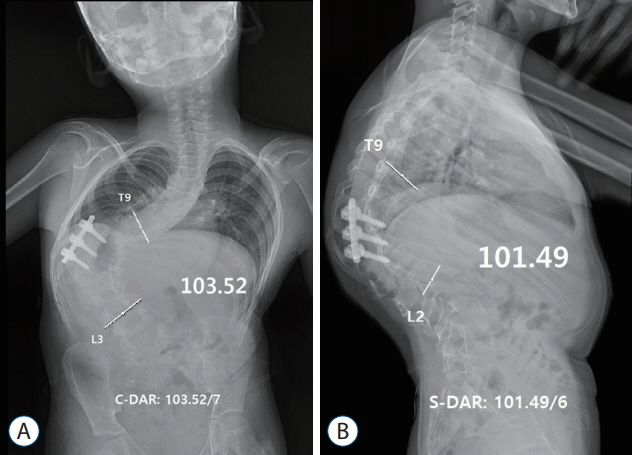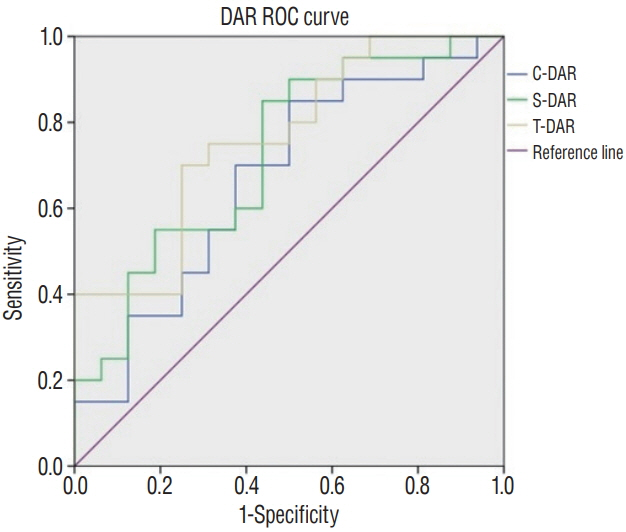J Korean Neurosurg Soc.
2018 Nov;61(6):723-730. 10.3340/jkns.2018.0125.
Total Deformity Angular Ratio as a Risk Factor for Complications after Posterior Vertebral Column Resection Surgery
- Affiliations
-
- 1Department of Neurosurgery, Hallym University Hangang Sacred Heart Hospital, Seoul, Korea.
- 2Department of Neurosurgery, Spine Center, Seoul National University Bundang Hospital, Seoul National University College of Medicine, Seongnam, Korea. hyunsj@snu.ac.kr
- 3Department of Neurosurgery, Chungnam National University Hospital, Chungnam National University College of Medicine, Daejeon, Korea.
- 4Department of Neurosurgery, Spine Center, Hyundai UVIS Hospital, Incheon, Korea.
- KMID: 2428114
- DOI: http://doi.org/10.3340/jkns.2018.0125
Abstract
OBJECTIVE
The aim of the present study was to identify whether the deformity angular ratio (DAR) influences the occurrence of complications after posterior vertebral column resection (PVCR) and to establish the DAR cut-off value.
METHODS
Thirty-six consecutive patients undergoing PVCR from December 2010 to October 2016 were reviewed. The relationships between the total, sagittal, and coronal DAR and complications were assessed using receiver operator characteristics curves. The patients were divided into two groups according to a reference value based on the cut-off value of DAR. Demographic, surgical, radiological, and clinical outcomes were compared between the groups.
RESULTS
There were no significant differences in the patient demographic and surgical data between the groups. The cut-off values for the total DAR (T-DAR) and the sagittal DAR (S-DAR) were 20.2 and 16.4, respectively (p=0.018 and 0.010). Both values were significantly associated with complications (p=0.016 and 0.005). In the higher T-DAR group, total complications (12 vs. 21, p=0.042) and late-onset complications (3 vs. 9, p=0.036) were significantly correlated with the T-DAR. The number of patients experiencing complications (9 vs. 11, p=0.029) and the total number of complications (13 vs. 20, p=0.015) were significantly correlated with the S-DAR. Worsening intraoperative neurophysiologic monitoring was more frequent in the higher T-DAR group (2 vs. 4) than in the higher S-DAR group (3 vs. 3). There was no difference in neurological deterioration between the groups after surgery.
CONCLUSION
Both the T-DAR and the S-DAR are risk factors for complications after PVCR. Those who had a T-DAR >20.2 or S-DAR >16.4 experienced a higher rate of complications after PVCR.
Keyword
MeSH Terms
Figure
Reference
-
References
1. Boachie-Adjei O, Bradford DS. Vertebral column resection and arthrodesis for complex spinal deformities. J Spinal Disord. 4:193–202. 1991.
Article2. Bradford DS, Tribus CB. Vertebral column resection for the treatment of rigid coronal decompensation. Spine (Phila Pa 1976). 22:1590–1599. 1997.
Article3. Demirkiran G, Dede O, Karadeniz E, Olgun D, Ay vaz M, Yazici M. Anterior and posterior vertebral column resection versus posterior-only technique: a comparison of clinical outcomes and complications in congenital kyphoscoliosis. Clin Spine Surg. 30:285–290. 2016.
Article4. Enercan M, Ozturk C, Kahraman S, Sarıer M, Hamzaoglu A, Alanay A. Osteotomies/spinal column resections in adult deformity. Eur Spine J. 22 Suppl 2:S254–S264. 2013.
Article5. Hamzaoglu A, Alanay A, Ozturk C, Sarier M, Karadereler S, Ganiyusufoglu K. Posterior vertebral column resection in severe spinal deformities: a total of 102 cases. Spine (Phila Pa 1976). 36:E340–E344. 2011.6. Hassanzadeh H, Jain A, El Dafrawy MH, Ain MC, Mesfin A, Skolasky RL, et al. Three-column osteotomies in the treatment of spinal deformity in adult patients 60 years old and older: outcome and complications. Spine (Phila Pa 1976). 38:726–731. 2013.
Article7. Herbert JJ. Vertebral osteotomy; technique, indications and results. J Bone Joint Surg Am. 30:680–689. 1948.8. Hyun SJ, Lee BH, Park JH, Kim KJ, Jahng TA, Kim HJ. Proximal junctional kyphosis and proximal junctional failure following adult spinal deformity surgery. Korean J Spine. 14:126–132. 2017.
Article9. Hyun SJ, Lenke LG, Kim YC, Koester LA, Blanke KM. Comparison of standard 2-rod constructs to multiple-rod constructs for fixation across 3-column spinal osteotomies. Spine (Phila Pa 1976). 39:1899–1904. 2014.
Article10. Kim SS, Cho BC, Kim JH, Lim DJ, Park JY, Lee BJ, et al. Complications of posterior vertebral resection for spinal deformity. Asian Spine J. 6:257–265. 2012.
Article11. Kim YJ, Hyun SJ, Cheh G, Cho SK, Rhim SC. Decision making algorithm for adult spinal deformity surgery. J Korean Neurosurg Soc. 59:327–333. 2016.
Article12. Leatherman KD, Dickson RA. Two-stage corrective surgery for congenital deformities of the spine. J Bone Joint Surg Br. 61-B:324–328. 1979.
Article13. Lee BH, Hyun SJ, Kim KJ, Jahng TA, Kim YJ, Kim HJ. Clinical and radiological outcomes of posterior vertebral column resection for severe spinal deformities. J Korean Neurosurg Soc. 61:251–257. 2018.
Article14. Lee BH, Hyun SJ, Park JH, Kim KJ. Single stage posterior approach for total resection of presacral giant schwannoma: a technical case report. Korean J Spine. 14:89–92. 2017.
Article15. Lenke LG, Newton PO, Sucato DJ, Shufflebarger HL, Emans JB, Sponseller PD, et al. Complications after 147 consecutive vertebral column resections for severe pediatric spinal deformity: a multicenter analysis. Spine (Phila Pa 1976). 38:119–132. 2013.
Article16. Lewis ND, Keshen SG, Lenke LG, Zywiel MG, Skaggs DL, Dear TE, et al. The deformity angular ratio: does it correlate with high-risk cases for potential spinal cord monitoring alerts in pediatric 3-column thoracic spinal deformity corrective surgery? Spine (Phila Pa 1976). 40:E879–E885. 2015.17. Makhni MC, Shillingford JN, Laratta JL, Hyun SJ, Kim YJ. Restoration of sagittal balance in spinal deformity surgery. J Korean Neurosurg Soc. 61:167–179. 2018.
Article18. Park YS, Hyun SJ, Kim KJ, Jahng TA. Multiple intradural disc herniations masquerading as intradural extramedullary tumors: a case report and review of the literature. Korean J Spine. 13:30. 2016.
Article19. Smith JS, Wang VY, Ames CP. Vertebral column resection for rigid spinal deformity. Neurosurgery. 63(3 Suppl):A177–A182. 2008.
Article20. Suk SI, Chung ER, Kim JH, Kim SS, Lee JS, Choi WK. Posterior vertebral column resection for severe rigid scoliosis. Spine (Phila Pa 1976). 30:1682–1687. 2005.
Article21. Suk SI, Kim JH, Kim WJ, Lee SM, Chung ER, Nah KH. Posterior vertebral column resection for severe spinal deformities. Spine (Phila Pa 1976). 27:2374–2382. 2002.
Article22. Wang H, Guo J, Wang S, Yang Y, Zhang Y, Qiu G, et al. Instrumentation failure after posterior vertebral column resection in adult spinal deformity. Spine (Phila Pa 1976). 42:471–478. 2017.
Article23. Wang XB, Lenke LG, Thuet E, Blanke K, Koester LA, Roth M. Deformity angular ratio describes the severity of spinal deformity and predicts the risk of neurologic deficit in posterior vertebral column resection surgery. Spine (Phila Pa 1976). 41:1447–1455. 2016.
Article24. Wang Y, Xie J, Zhao Z, Zhang Y, Li T, Bi N, et al. Perioperative major non-neurological complications in 105 patients undergoing posterior vertebral column resection procedures for severe rigid deformities. Spine (Phila Pa 1976). 40:1289–1296. 2015.
Article25. Xie J, Wang Y, Zhao Z, Zhang Y, Si Y, Li T, et al. Posterior vertebral column resection for correction of rigid spinal deformity curves greater than 100°. J Neurosurg Spine. 17:540–551. 2012.
Article26. Zhang BB, Zhang T, Tao HR, Wu TL, Duan CG, Yang WZ, et al. Neurological complications of thoracic posterior vertebral column resection for severe congenital spinal deformities. Eur Spine J. 26:1871–1877. 2017.
Article
- Full Text Links
- Actions
-
Cited
- CITED
-
- Close
- Share
- Similar articles
-
- Posterior Vertebral Column Resection for Severe Spinal Deformities
- Three-Column Osteotomy for the Treatment of Rigid Cervical Deformity
- Severe Rigid Scoliosis: Review of Management Strategies and Role of Spinal Osteotomies
- Complications of Posterior Vertebral Resection for Spinal Deformity
- A Review of Complications and Outcomes following Vertebral Column Resection in Adults



